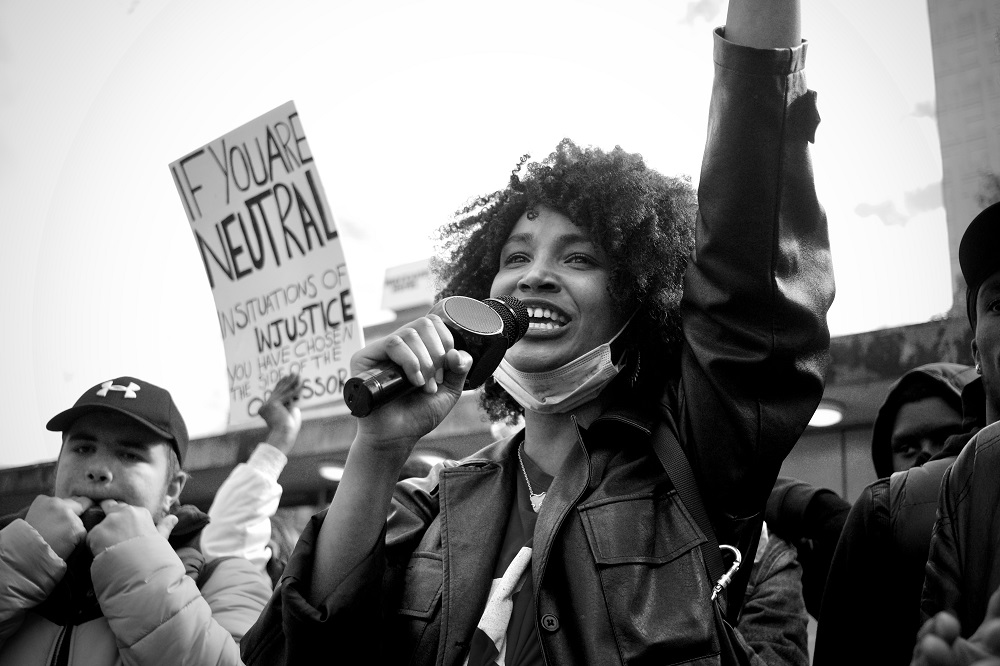Tweeting Abolition in an Age of Mass Incarceration and Social Unrest, Part I: What is Abolition?
by Julian G. Thompson (@JulianGThompson), Department of Criminology, Law, and Justice at University of Illinois at Chicago, and Rob Eschmann (@robeschmann), School of Social Work at Columbia University · Published · Updated

For many people in the United States and the world over, 2020 was a pivotal year for learning about and engaging in radical protests against extrajudicial killings of Black and Latinx people by police officers. It was a year that brought a lot of attention to the now common slogan “defund the police,” especially after Minneapolis police officer Derek Chauvin killed George Floyd. As the world had also come to a screeching halt because of the global Coronavirus pandemic, with many of us having to shelter in place, the 2020 uprisings represented both the pent-up frustrations of being isolated and the exhaustion of Black folks being murdered by those who claimed to serve and protect. In this odd mix of heightened emotional, political, and social turmoil, news articles repeatedly framed their headlines with questions of “what does it mean to defund the police?” Few people grasped its meaning, while many could not imagine having less police officers in their community.
This demand to defund the police was not an anomaly, nor was it an impractical or idealized vision. In fact, it was just one demand of many that emerged from years of organizing and building a movement to abolish deleterious systems of oppression (including law enforcement and the criminal legal system) to alleviate harm, suffering, and punishment unjustly and unfairly enacted against racialized groups. The call to defund the police, in fact, originated as an abolitionist demand from radical voices within the Black Lives Matter movement.[1]
Abolition is a theory of change coupled with a set of practices that are important to create that change. It is a critical praxis – a melding of theory and action – grounded in intersectional feminism and used to diagnose, disrupt, and transform power structures that create vulnerability and operate as oppressive forces. In the United States, its origin of thought stems both from the movement to abolish slavery, as well as the idea that the knowledge and speculative efforts of maroons (fugitives from slavery) provide key insights for imagining a world without slavery and colonialism. For Maroons, fighting for freedom was a matter of life and death. Maroons not only revolted against slavery but were also forced to find ways to survive as they continued to face the threat of re-enslavement.[2] Living under such conditions required a sense of urgency to abolish slavery and uncertainty about the future.
In today’s terms, abolitionists build on these lessons to think about how systems of oppression create life-threating conditions and experiences. They argue that eradicating oppression and fighting for immediate change is necessary to build life-sustaining communities, and that slow and gradual processes of change often sustain conditions that lead to premature death. With this in mind, abolitionists center 1) the lived experiences of oppressed groups, 2) the ongoing state of urgency and uncertainty that they face under oppression, and 3) the unique knowledge that they hold when resisting oppression and when finding alternative models to sustain life beyond or outside oppressive systems and their norms.
Abolitionists have been organizing and radically pushing for deep and enduring transformation of the prison-industrial-complex since the 1990s, and prior to that in the 1960s and 1970s long before mass incarceration was an egregious phenomenon. Additionally, abolitionists have been writing literature, developing organizations, launching local campaigns, creating conferences, engaging in community-based programs, mutual aid efforts, and directly teaching or working with students, organizers, social movement activists, and others who may have found their way to the Movement for Black Lives in 2013. Yet the questions of “what is prison abolition?” and “what are abolitionists fighting for?” have remained.
One of the goals of abolitionist thought is to challenge the dominant ways of thinking about crime and punishment. For example, abolitionists argue that the criminal legal system dishes out punishment and point out the ways that it fails, including 1) failing to remedy or repair the harm that someone commits, 2) excluding or exploiting the voices and experiences of victims in the name of punishment, 3) inflicting pain and suffering on offenders, victims, families, and others, with lasting effects even after incarceration ends, 4) offering few opportunities or pathways to redemption, restoration, or healing, and 5) functioning as an institution of social control against people living at the margins and whose identities and social conditions are often criminalized.
Abolitionists are equally concerned with building different kinds of democratic and life-sustaining alternatives while simultaneously fighting to dismantle current systems of oppression, including but not limited to our criminal legal system, Immigration and Customs Enforcement (ICE), practices of surveillance, and law enforcement. When people hear “prison abolition” they automatically think that abolitionists are looking to take a wrecking ball to jails and prisons or the police force without concern for public safety, harm, or danger.
To the contrary, abolitionists see these various state institutions and the rationalities that proceed from them as extremely harmful and deeply imbricated with other oppressive forces that diminish the life chances of vulnerable groups. And in response, they continually engage in community-based efforts to build social experiments that operate outside of the logics and practices of the criminal legal system.
Instead of relying on this complex regime of punishment, then, abolitionists aim to build models of accountability, healing, and justice—such as transformative justice, restorative justice, healing justice, and community accountability—to locally mediate and resolve human conflict, including violence, while offering pathways for change across multiple domains: for the victim, the community, the harm-doer, and others.
Of course, these models of justice are not meant to be easy or readily scalable. Rather, they are intended to be multiplied, built on, re-shaped for community needs, and serve as viable strategies that are not rooted in vengeance but instead engage a wide set of actors and circumstances for change. If the process of the criminal legal system is punishment, then the process for these other models is a reparative, active, and participatory form of accountability.
Where most people imagine that law enforcement and the criminal legal system eliminate harm and create public safety, abolitionists simply argue that public safety is best ensured by transforming the conditions that produce harm and by building processes that allow people to take accountability in ways that lead to opportunities for repair, restoration, and healing.
Few people understand what defines abolitionism and what abolitionists have been aiming to achieve. Few even knew that it was abolitionists who first called for defunding the police. But it is the growth and uptake of abolitionist thinking and movement-building work performed by activists online and in the streets that made it possible for “defunding” to be a part of our current conversations—regardless of how divisive or controversial the idea may be. For more on this trend, see the soon-to-be-published Part II of this article, “Tweeting Abolition: From the Margins to the Mainstream,” or our new peer-reviewed paper, “Tweeting Towards Transformation: Prison Abolition and Criminal Justice Reform in 140 Characters,” which can be accessed for free here.
[1] McDowell, M. G., & Fernandez, L. A. (2018). ‘Disband, disempower, and disarm’: Amplifying the theory and practice of police abolition. Critical Criminology, 26(3), p 377.
[2] Sudbury, J. (2009). Maroon abolitionists: Black gender-oppressed activists in the anti-prison movement in the US and Canada. Meridians, 9(1), 1-29.
For more information and the full list of references, please check out our Open Access publication at Sociological Inquiry:
Eschmann, R., Thompson, J. G., & Toraif, N. (2022). Tweeting toward transformation: Prison abolition and criminal justice reform in 140 characters. Sociological Inquiry. https://doi.org/10.1111/soin.12503




1467-7660/asset/DECH_right.gif?v=1&s=a8dee74c7ae152de95ab4f33ecaa1a00526b2bd2)
